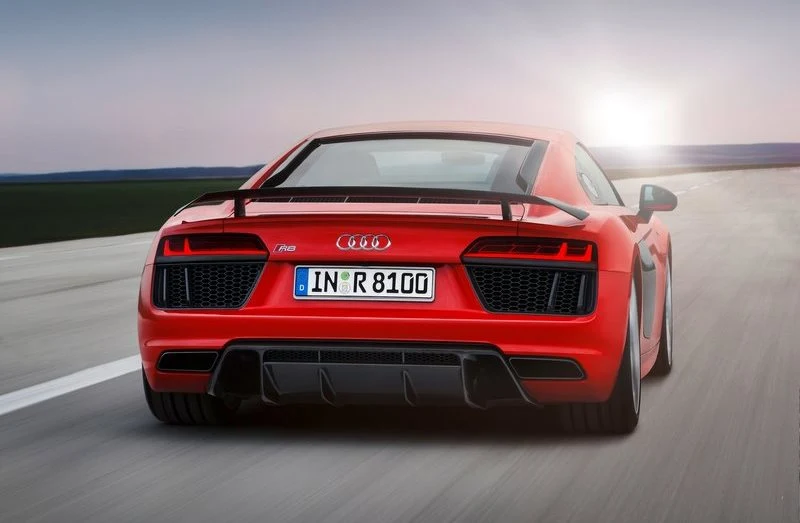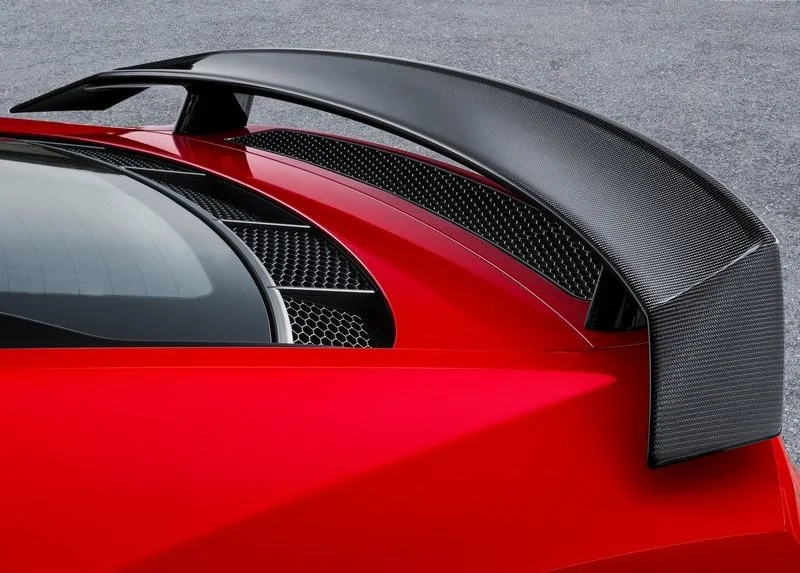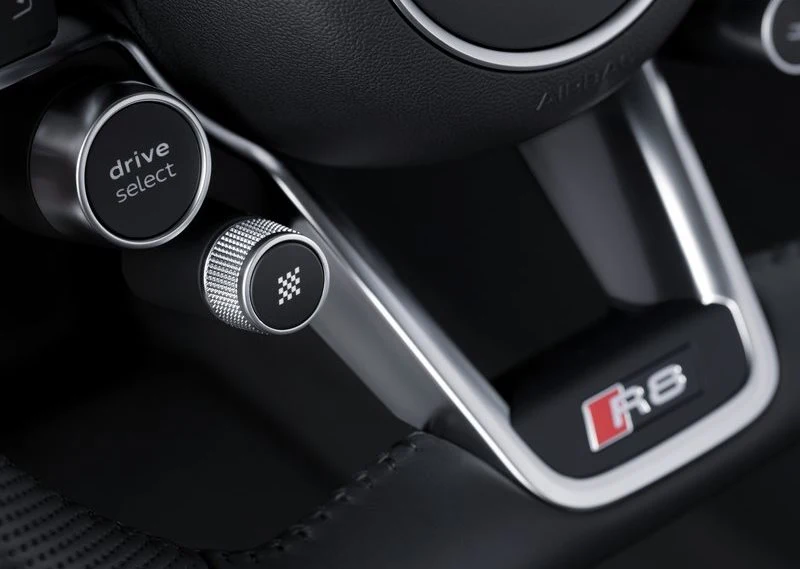Price: $117,150
The second generation of Audi’s performance flagship is a true superstar. If Audi’s original R8 was the luxury marque putting out feelers in the high-end sports car market, the new second generation
model is Audi marking its territory.
Because in the eight years since the first R8 appeared, the German number has established itself firmly as a genuine member of the club, standing toe to toe with Ferraris, Lamborghinis, McLarens and top-of-the-line 911s. The formula remains exactly the same: cab-forward, mid engined two-seater, built around a space frame and with all-wheel-drive. Audi has done nothing radically different with this second-gen model, but has improved it incrementally in every way.
Take a look, for instance, at the car’s space frame that forms the “skeleton” onto which everything else is hung. Instead of being cast solely from aluminium as was the case before, it is now crafted from a mix of aluminium and carbon fibre-reinforced polymer (CFRP). This shaves 10kg off the weight of its predecessor and, critically, also makes the structure 40 percent stiffer.
The exterior body panels cladding that spaceframe are all-aluminium, as before. The 5.2-litre V10 powerplant makes a reappearance, in two states of tune. The “base” version in the standard R8 V10 delivers 540bhp and 540Nm of torque, while the one in the R8 V10 Plus ups the stakes massively with 610bhp and 560Nm. That latter set of figures, incidentally, is exactly what this same engine delivers in the R8’s sister supercar, the Lamborghini Huracan. It revs to a thrilling 8700rpm,
and delivers a hair-tingling soundtrack that morphs from serrated throb at low revs to hard-edged track car howl at the top end.
In a nod to the greenies, automatic stop-start now features on the car, as well as a “coasting” mode that disengages the clutch and drops the revs to idle when you lift off the throttle pedal at cruising speeds. The 4.2-litre V8 from the old R8 isn’t off ered in the new model. Still, it’s very likely
that a V8 version will appear at some point, although the Audi chaps at the launch were tight-lipped about this. The styling has been sharpened, literally, with more angular and wedge-shaped head- and tail-lamps, squarer and more aggressive front bumper intakes, and a more jutting grille with chamfered top corners in the latest Audi fashion.
The car looks even more “cab-forward” now, with the glasshouse sitting slightly further forward and the rear deck more gently sloped and stretching further back. As before, there are contrasting coloured “side blades” running vertically down the flanks just behind the doors, although they are now interrupted by the coupe’s shoulder line, where the earlier ones were continuous, one-piece items.
General proportions and overall dimensions remain very similar to the previous R8’s, but the new model is a touch shorter, lower and wider. All in, it’s a clever and sensitive design update, the newcomer looking more spectacular than ever without dating the predecessor. Audi is especially proud of the new headlamps. They adopt the all-LED technology of the outgoing R8 V10, but add laser high-beams to their arsenal. Those headlamps are brilliant – in both senses of the word.
Apart from casting a bright as- daylight beam hundreds of metres into the distance, they switch themselves off when the sensors detect an oncoming car or when speeds drop below 40km/h, and turn themselves on again above 60km/h.
As with the styling, the cabin of the new R8 is the result of gradual evolution. The “monoposto” layout, which angles the centre console towards the driver and puts all essential controls within his reach, remains.
The instrument cluster is now a “virtual” TFT one, as first seen on the recently launched Audi
TT. Sat-nav and multimedia information now appear there instead of on a central screen, and the display can be configured to prioritise either the sat-nav map or the rev counter.
Apart from the usual Comfort/ Auto/Dynamic/Individual settings in the Drive Select menu,
the V10 Plus has three subsettings when in Dynamic mode: Dry, Wet and Snow. These tailor the differential settings to suit the grip conditions underfoot.
You now choose your preferred Drive Select mode via a large round button on the steering wheel. The starter switch has also migrated from the centre console to the steering wheel, and on the V10 Plus, the Dynamic Mode Select knob and exhaust valve switch join them there as well. It’s a
more driver-centric solution than before, and also tidies up the cockpit somewhat.
The Plus model also has carbon-ceramic brakes as standard, a fixed carbon fibre rear wing instead of the non- Plus model’s retractable device, and a firmer suspension setup (although both models also
have the option of electronically adaptive dampers).
Drive reaches all four wheels via a 7-speed S tronic dual-clutch transmission (there is no longer
a manual alternative), while a new electro-hydraulic multiplate clutch allows infinitely
variable apportionment of torque between the axles. Unlike its predecessor, the new R8
can, depending on conditions, be front-drive or rear-drive only, or anything in between.
The all-wishbone setup of the previous R8’s chassis has been retained, and for good reason. The R8 has always had an exquisite handling balance coupled with a beautifully controlled ride, and this remains the case with the new model.
The steering seems quicker geared than before, the car nosing into bends very keenly with a roll of the driver’s wrists, although subjectively, it also feels a touch lighter and less linear now. This could be down to the optional Dynamic Steering fitted to our test cars at the launch event – it varies the steering ratio depending on speed. It involves less arm-twirling than the fixed ratio rack of its predecessor, but the side effect seems to be a slight loss of the old car’s wonderful tactility through the helm and its fluidity.
I’ll reserve judgment on this till I try the new R8 without Dynamic Steering. Grip is ferocious, and as I discovered on a few flat-out laps of the daunting Portimao Circuit in southern Portugal, at the very
limit I can feel the car start to move laterally, but progressively and gradually. Give it more power and the tail will edge out, but never suddenly or without warning, and it’s possible to hold it at that consistent angle quite confidently, all the way around.
For a car so planted and agile, the ride is remarkably good – pliant enough to shrug off poor surfaces without upsetting the vehicle’s trajectory, yet resolutely controlled over undulations and utterly resistant to body roll. Straight-line performance is tremendous, of course, ranging from storming (standard R8 V10) to eye-watering (V10 Plus). The engine is extremely strong right from idle speeds, and simply belts up to its 8700rpm rev limit time and again as the gearchanges fire through slickly
on that dual-clutch gearbox.
But the gearchanges, immediate as they are, could do with more tactile ferocity, especially at high revs where the rival dual-clutch units in Ferraris, Porsches and even BMW M cars deliver such a thrill. The century sprint times are 3.5 seconds for the regular V10 and 3.2 seconds for the
Plus – supercar figures.
Given all that pace, it is a good thing the optional carbon ceramic brakes are indomitable, as they proved by hauling me down from high three-figure speeds repeatedly for the hairpins on my track laps. The new R8 is an entirely predictable but worthy sequel to its seminal predecessor.
The V10 and V10 Plus models are both stunningly accomplished and hugely desirable creations,
although with a price to match – the new R8 V10 Plus is likely to carry a price tag well in excess of $900k when it lands here next year. There is still room above the two R8 models to introduce a
hardcore, lightweight version for committed track-day enthusiasts, but as an everyday supercar, the new R8 as it now stands is almost without peer.
The R8’s 5.2-litre 10-cylinder produces either 540bhp/ 540Nm or 610bhp/ 560Nm – the latter output being the same ast Lambo
DRIVETRAIN
TYPE
V10, 40-valves
CAPACITY
5204cc
BORE X STROKE
84.5mm x 92.8mm
COMPRESSION RATIO
12.5:1
MAX POWER
540bhp at 7800rpm
MAX TORQUE
540Nm at 6500rpm
POWER TO WEIGHT
338.6bhp per tonne
GEARBOX
7-speed dual-clutch
with manual select
DRIVEN WHEELS
All
PERFORMANCE
0-100KM/H
3.5 seconds
TOP SPEED
320km/h
CONSUMPTION
8.8km/L (combined)
CO2 EMISSION
272g/km
SUSPENSION
FRONT
Double wishbones, coil springs,
anti-roll bar
REAR
Double wishbones, coil springs,
anti-roll bar
The R8’s all-new sport seats offer several upholstery and colour choices, plus 226 litres of cargo space behind them.
The driver centric cockpit nowhas more drama and gadgets, including a set of “press play” buttons on the steering wheel of the V10 Plus variant.



























Post a Comment